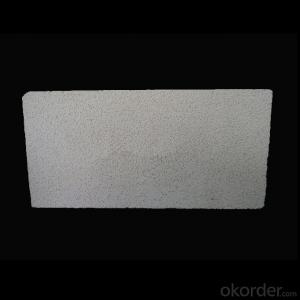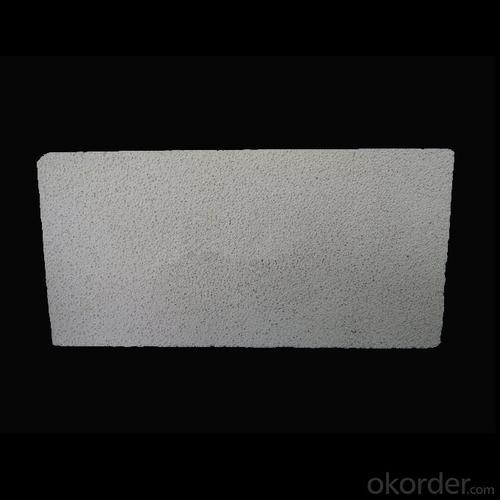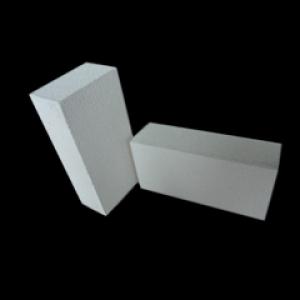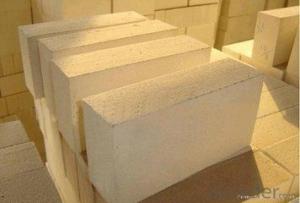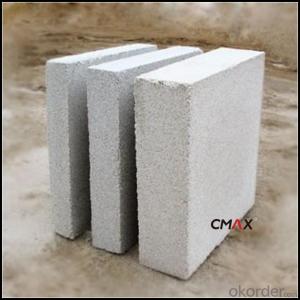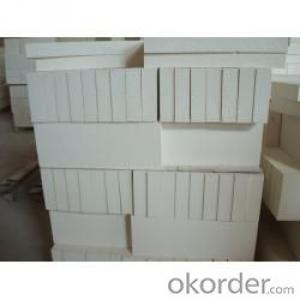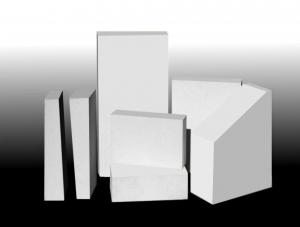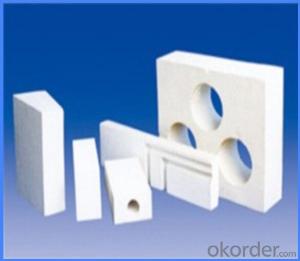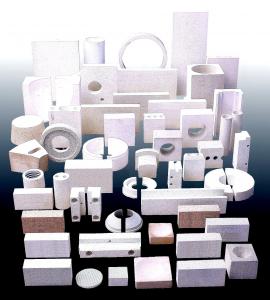High-Quality Insulating Fire Brick
- Loading Port:
- Shanghai
- Payment Terms:
- TT OR LC
- Min Order Qty:
- 10 m.t.
- Supply Capability:
- 100 m.t./month
OKorder Service Pledge
OKorder Financial Service
You Might Also Like
Quick Details
| Place of Origin: | (Mainland) | Shape: | Brick | Material: | Alumina Block |
| SiO2 Content (%): | 55-15% | Al2O3 Content (%): | 35-75% | MgO Content (%): | 0.1% |
| CaO Content (%): | 0.1% | Refractoriness (Degree): | 1770°< Refractoriness< 2000° | CrO Content (%): | 0.1% |
| SiC Content (%): | 0.1% | Model Number: | 230*114*65 | Brand Name: | |
| color: | yellow | Bulk density: | 2.1g/cm3 |
Packaging & Delivery
| Packaging Detail: | wooden pallet packing |
| Delivery Detail: | within 20 days |
Product Description
Refractory brick
1) Good thermal shock resistance
2) High-temperature endurable
3) Good thermal insulation
4)the using tempreture is 1450 C
Physiochemical index
Item | Fireclay brick | High Alumina Brick | ||||
SK32 | SK34 | SK35 | SK36 | SK37 | SK38 | |
Al2O3 (%) ≥ | 35 | 42 | 48 | 55 | 65 | 75 |
Refractoriness (oC) ≥ | 1670 | 1730 | 1750 | 1770 | 1790 | 1790 |
Refractoriness under Load, oC,0.2MPa ≥ | 1250 | 1300 | 1420 | 1470 | 1500 | 1520 |
Linear Change(%),oC×2h | 1350 | 1350 | 1450 | 1500 | 1500 | 1500 |
-0.5~0 | -0.5~0 | -0.4~+0.1 | -0.4~+0.1 | -0.4~+0.1 | -0.4~+0.1 | |
Porosity (%)≤ | 24 | 22 | 20 | 20 | 19 | 19 |
Cold Crushing Strength, MPa≥ | 20 | 30 | 39.2 | 44.1 | 49 | 53.9
|
- Q: Are insulating fire bricks safe to use?
- Yes, insulating fire bricks are safe to use. They are specifically designed to withstand high temperatures and are made from non-toxic materials that do not emit harmful gases or substances when heated. They provide excellent insulation and are commonly used in various applications such as kilns, furnaces, and fireplaces.
- Q: Can insulating fire bricks be used in chimneys?
- Yes, insulating fire bricks can be used in chimneys. Insulating fire bricks are designed to withstand high temperatures, making them an ideal choice for lining chimneys. They have excellent thermal insulation properties, which help to prevent heat loss and increase the efficiency of the chimney. Additionally, insulating fire bricks are lightweight and easy to install, making them a convenient option for chimney lining. However, it is important to note that insulating fire bricks are not suitable for all types of chimneys. It is recommended to consult a professional or chimney specialist to determine the appropriate materials for your specific chimney needs.
- Q: Are insulating fire bricks resistant to moisture penetration?
- Yes, insulating fire bricks are resistant to moisture penetration. These bricks are designed to have low porosity, which means they have a very low water absorption rate. This characteristic makes them highly resistant to moisture penetration. Insulating fire bricks are commonly used in applications where they are exposed to high temperatures and harsh conditions, such as kilns, furnaces, and fireplaces. Their resistance to moisture penetration ensures their durability and effectiveness in these environments.
- Q: Are insulating fire bricks resistant to thermal conductivity?
- Yes, insulating fire bricks are designed to have low thermal conductivity, which means they are resistant to the transfer of heat.
- Q: Can insulating fire bricks be used in the construction of pottery molds?
- Insulating fire bricks are indeed applicable for the construction of pottery molds. Crafted from lightweight refractory materials, these bricks possess exceptional heat insulation qualities. Specifically engineered for high-temperature applications like pottery kilns, they offer a range of benefits. When constructing pottery molds, it is imperative to utilize materials that can endure the kiln's intense heat. Insulating fire bricks can withstand temperatures of up to 3000°F (1650°C), rendering them ideal for pottery mold construction. They provide insulation to prevent heat dissipation and maintain consistent temperatures within the kiln, crucial for achieving the desired firing results. Moreover, insulating fire bricks can be conveniently shaped and cut to suit the designated mold design. Their lightweight nature also simplifies handling during the mold construction process. Additionally, the insulating properties of these bricks curtail energy consumption by preventing excessive heat loss, making them a cost-effective choice in the long term. All in all, insulating fire bricks prove to be a fitting option for constructing pottery molds due to their capacity to withstand high temperatures, offer insulation, and be easily molded to meet specific design requirements.
- Q: What is the cost of insulating fire bricks?
- The cost of insulating fire bricks can vary depending on factors such as the size, quantity, and supplier. Generally, they can range from a few dollars per brick to around $10-20 per brick. It is recommended to research and compare prices from different suppliers to find the best deal.
- Q: Are insulating fire bricks resistant to phosphoric acid?
- Yes, insulating fire bricks are resistant to phosphoric acid.
- Q: Can insulating fire bricks be used in the construction of industrial dryers?
- Yes, insulating fire bricks can be used in the construction of industrial dryers. Insulating fire bricks are specifically designed to have low thermal conductivity, which means they are able to retain heat and prevent heat loss. This makes them an excellent choice for applications that require high temperatures, such as industrial dryers. Insulating fire bricks are made from lightweight materials such as clay, silica, and alumina, and are capable of withstanding temperatures of up to 3000°F (1650°C). They have excellent insulation properties, which help to reduce energy consumption and improve the overall efficiency of the industrial dryer. Additionally, insulating fire bricks are resistant to thermal shock, meaning they can withstand rapid temperature changes without cracking or breaking. This is particularly important in industrial dryer applications, where temperatures can fluctuate quickly. Overall, insulating fire bricks are a suitable choice for the construction of industrial dryers due to their low thermal conductivity, high temperature resistance, and ability to withstand thermal shock.
- Q: What is the typical compressive strength of an insulating fire brick?
- The compressive strength of an insulating fire brick typically varies due to differences in composition and the process used for manufacturing. On average, these bricks have a compressive strength that falls between 1,000 pounds per square inch (psi) and 3,000 psi. They are specifically engineered to endure extreme temperatures and offer thermal insulation in a range of applications, including kilns, furnaces, and fireplaces. The ability of these bricks to withstand crushing and uphold their structural integrity while under load is directly influenced by their compressive strength, making it a crucial characteristic.
- Q: How do insulating fire bricks affect the overall noise reduction of a structure?
- Insulating fire bricks play a crucial role in reducing the overall noise levels within a structure. These bricks are specifically designed to have excellent sound absorption properties, making them highly effective in reducing noise transmission. The high-density and low-porosity nature of insulating fire bricks allows them to absorb and dampen sound waves effectively. When sound waves pass through the bricks, the energy of the waves is converted into heat due to the internal friction of the material. This conversion process helps to minimize the transmission of sound, resulting in a quieter environment. Additionally, insulating fire bricks are known for their thermal insulation properties, which indirectly contribute to noise reduction. These bricks help in maintaining a stable temperature within the structure, preventing the expansion and contraction of materials that can generate unwanted noise. It is worth mentioning that the impact of insulating fire bricks on noise reduction may vary depending on the specific construction and design of the structure. The thickness and placement of the bricks, as well as the presence of other sound-absorbing materials, should be considered to achieve the desired level of noise reduction. In summary, insulating fire bricks significantly contribute to the overall noise reduction of a structure by absorbing and dampening sound waves. Their ability to convert sound energy into heat, along with their thermal insulation properties, makes them an effective solution for creating a quieter environment.
Send your message to us
High-Quality Insulating Fire Brick
- Loading Port:
- Shanghai
- Payment Terms:
- TT OR LC
- Min Order Qty:
- 10 m.t.
- Supply Capability:
- 100 m.t./month
OKorder Service Pledge
OKorder Financial Service
Similar products
Hot products
Hot Searches
Related keywords
